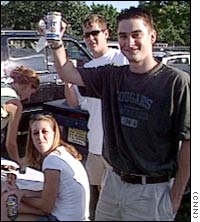
NEW YORK (CNN/Money) -
It might seem easier to get college fraternities to give up their beer than it is to get college athletics to give up their beer money.
 |
|
| Beer, and money from beer companies, have become integral parts of college sports. |
The chances of watching alcohol-free bowl games and basketball tournaments are about the same as the odds of seeing MIT playing for a national championship. But that's not going to stop some dedicated activists from trying to wring the alcohol dollars out of sports.
Beer and other alcohol companies spent $50 million advertising on college sports broadcasts last year, according to the Sports Business Journal. That's about 5 percent of the $1 billion in advertising spent on those games overall.
Many schools and conferences get direct sponsorship dollars, too. One Big 12 school got as much as $450,000, according to the publication. The Journal found that 45 percent of the Division 1A football schools get direct sponsorship dollars from alcohol companies, and another 25 percent get indirect money through advertising.
The effort shut off the alcohol's ad and sponsorship dollar tap is being led by the Center for Science in the Public Interest, and backed by the Center on Alcohol Marketing and Youth. But it's not just modern day Carrie Nations getting into the game. Some of the highest profile leaders of the effort come from the inner sanctum of big time: big dollar college athletics.
Among those leading the charge are Ohio State athletic director Andy Geiger, Penn State football coach Joe Paterno and U.S. Rep. Tom Osborne, R-Neb., the former coach of the University of Nebraska football team.
"Alcohol abuse is the leading cause of death on college campuses," said Osborne, who has introduced a non-binding resolution in Congress urging schools and the NCAA to stop taking money from beer and booze concerns.
But Osborne is realistic about the chances for even his relatively mild resolution getting through Congress. He's had trouble getting co-sponsors, not surprising given the fact that about 85 percent of the House and two-thirds of the Senate have received campaign contributions from the beer, wine or spirits industry in the current election cycle.
“ Alcohol abuse is the leading cause of death on college campuses. ”
 U.S. Rep. Tom Osborne
U.S. Rep. Tom Osborne
Former Nebraska football coach
|
"The alcohol industry has lobbied very hard on this issue. I've had people tell me they've been told to stay away from Tom Osborne on this issue," he said.
But Osborne, Geiger and others in the movement are more hopeful they can eventually convince the colleges that make up the NCAA to push for a ban through that body.
"I just think it's the right thing to do," says Osborne.
"The discussion has increased enormously within the schools of the NCAA in the last year," said George Hacker, director of the Alcohol Policies Project at the CSPI. "We're on the right track, but those few schools that really profit from the relationship have the toughest decision to make."
Ohio State is one of those schools. But after the Buckeyes' football victory over University of Michigan at the end of the 2002 set off a drunken riot on campus, Geiger decided things had to change.
He doesn't have control over the OSU's television contracts, but the school did negotiate with its radio rights holder to get it to stop selling ads to alcohol companies. That reduced the rights the school gets by about $85,000, money OSU hopes to recoup by selling the time itself to other advertisers.
| SportsBiz
|

|
| Click here for SI.com sports coverage
|
|
|
|
Geiger says it's hard to project how much a ban would eventually cost college athletics.
"There are other product lines that would buy that time," he said. "People would have to roll up their sleeves and work hard."
Sports broadcasting consultant Neal Pilson said that if all beer and alcohol dollars were banned from college sports, the rights fees would eventually take a hit.
"The significant dollars paid by Bud and other beer companies could not be replaced," he said. "There's not other money that would automatically flow if there was a complete ban."
The Beer Institute, the industry trade group, did not have an immediate comment on the efforts. In the past, its executives have argued that fewer than 10 percent of the viewers of sporting events are under-age. Advertising their products on the games, then, is an appropriate way to reach their target older audience.
So far, broadcasters are not particularly concerned.
"Down the road, if someone else creates different rules of the game, we have to play by them," said Loren Matthews, ABC Sports senior vice president of programming. But for now, he doesn't think there's anything wrong with accepting alcohol ads on college sports.
Pilson said that it's impossible to imagine a ban on alcohol ads on pro sports, where far more ad and sponsor dollars are spent. And without a ban on pro sports alcohol ads, he argues, a college-sports ban would be ineffective.
Geiger says he's not arguing that a ban would reduce campus drinking. For him the issue is mainly a matter of principle. "We'd like very much to see a reduction in the interdependence of beer and football," he said.
It'd be nice to see that kind of principled stand triumph. But when it comes to the world of big dollar college sports, such a principled effort will be too much for the decision makers to swallow.

|

